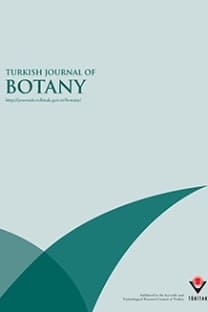Correlation between the morphological characters of pomegranate (Punica granatum) traits and their implications for breeding
Key words: Correlation, factor analysis, genotype, pomegranate, titratable acidity
Correlation between the morphological characters of pomegranate (Punica granatum) traits and their implications for breeding
Key words: Correlation, factor analysis, genotype, pomegranate, titratable acidity,
___
- Falconer DS & Mackay TFC (1996). Introduction to Quantitative Genetics, 4th edn. London: Addison-Wesley Longman Ltd.
- Garcia MG, Ontiver M, Diazricci JC & Castagnaro A (2002). Morphological traits resolution RAPD markers for the identification of the main strawberry varieties cultivated in Argentina. Plant Breeding 121: 76–80.
- Jalikop SH & Sampath-Kumar P (1990). Use of a gene marker to study the mode of pollination in pomegranate (Punica granatum L.). Journal of Horticultural Science 65: 221–223.
- Karimi HR, Zamani Z, Ebadi A & Fatahi MR (2009) Morphological diversity of Pistacia species in Iran. Genetic Resource Crop Evolution 56: 561–571.
- Levin GM (1994). Pomegranate (Punnica granatum L.) plant genetic resource in Turkmenistan. Plant Genetic Resource New 97: 31–
- Mars M (1996). Pomegranate genetic resources in the Mediterranean region. Proc. Plant Genetic Resources Meeting, Tenerife, Spain, 2-4 Oct 1995: 345–354.
- Mars M & Marrakchi M (1998). Conservation et valorisation des ressources génétiques du grenadier (Punica granatum L.) en Tunisie. Plant Genetic Resources Newsletter 118: 35–39.
- Sarkhosh A, Zamani Z, Fatahi MR, Ebadi A, Saie A, Tabatabaie SZ & Akrami MR (2007). Study of relationships among fruit quantitative and qualitative characteristics of some pomegranate genotypes. Journal of Science and Technology Agriculture and Natural Resources 10: 147–160; in Farsi.
- Sheikh Akbar Mehr R, Maassoumi AA, Saidi A, Kazempour Osaloo Sh & Ghorbani Nohooji M (2012). Morphological cladistic analysis of some bifurcate hairy sections of Astragalus (Fabaceae) in Iran. Turkish Journal of Botany 15: 25–38.
- Tancred SJ, Zeppa AG, Cooper M & Stringer JK (1995). Heritability and patterns of inheritance of the ripening date of apples. Horticultural Science 30: 325–328.
- Zamani Z, Sarkhosh A, Fatahi R & Ebadi A (2006). Genetic relationships among pomegranate genotypes studied by fruit characteristics and RAPD markers. Journal of Horticultural Science and Biotechnology 82: 11–18.
- Zhang L, Gao Y, Zhang Y, Liu J & Yu J (2010). Change in bioactive compounds and antioxidant activities in pomegranate leaves. Scientia Horticulturae 123: 543–546.
- ISSN: 1300-008X
- Yayın Aralığı: 6
- Yayıncı: TÜBİTAK
Three new macrofungi records for Turkey
Halil GÜNGÖR, Hakan ALLI, Mustafa IŞILOĞLU
Seed coat ultrastructure of hard-seeded and soft-seeded varieties of Vicia sativa
Hatice Nurhan BÜYÜKKARTAL, Hatice ÇÖLGEÇEN, Nur Münevver PINAR, Neslihan ERDOĞAN
The flora of Yıldız Mountains (Kırklareli) Biosphere Project area
Emine AKALIN URUŞAK, Fatma Neriman ÖZHATAY, Necmettin GÜLER, Hüseyin ERSOY
Dianthus vanensis (Caryophyllaceae), a new species from Turkey
Ahmet İLÇİM, Lütfi BEHÇET, Muzaffer MÜKEMRE
Seasonal variability of phytoplankton in a coastal lagoon and adjacent open sea in Pakistan
Saima LATIF, Zarrien AYUB, Ghazala SIDDIQUI
Salih MUTLU, Ömer KARADAĞOĞLU, Ökkeş ATICI, Esen TAŞĞIN, Barbaros NALBANTOĞLU
Three remarkable new moss records for South-West Asia from northern Turkey
Hamid Reza KARIMI, Seyed Hossein MIRDEHGHAN
Contributions to the moss flora of the Al-Ghab plain (north-west Syria)
Adnan ERDAĞ, Mesut KIRMACI, İntissar TIZINI, Adnan KASHLAN, Badeea Charaf ADDINE
